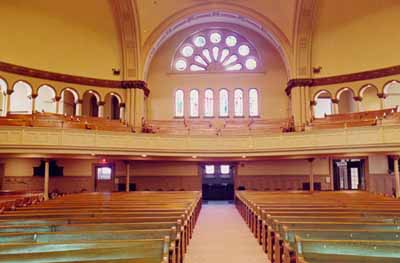Erskine and American United Church National Historic Site of Canada
Montréal, Quebec

General view
© Agence Parcs Canada / Parks Canada Agency, R. Goodspeed, 1997.
Address :
1339 Sherbrooke Street West, Montréal, Quebec
Recognition Statute:
Historic Sites and Monuments Act (R.S.C., 1985, c. H-4)
Designation Date:
1998-07-15
Dates:
-
1893 to 1894
(Construction)
-
1938 to 1939
(Alteration)
Event, Person, Organization:
-
Louis Comfort Tiffany (designer)
(Person)
-
Alexander Cowper Hutchinson
(Architect)
-
Percy E. Nobbs
(Architect)
Other Name(s):
-
Erskine and American United Church
(Designation Name)
Research Report Number:
1998-26
Description of Historic Place
The Erskine and American United Church National Historic Site of Canada is located in the Golden Square Mile of Montréal. Built in 1893-94, this Romanesque Revival style church contains stained glass windows by Louis Comfort Tiffany. The façade, crowned by a gable, includes a large demi-rose window above smaller windows framed by a massive central arch. Smaller towers balance the tall tower dominating the composition. The stonework is heavily rusticated. Official recognition refers to the interior and exterior of the building.
Heritage Value
The Erskine and American United Church was designated a national historic site of Canada in 1998 because; it is an excellent example of a large church designed in the Romanesque Revival style influenced by American architect Henry Hobson Richardson and remarkable for unusual fenestration patterns and attractive stonework; the cycle of windows by Louis Comfort Tiffany in the sanctuary and in the chapel are unique, as they form the most extensive collection of Tiffany’s religious stained glass windows in Canada; the interior of the church is an attractive and finely executed example of an amphitheatre plan, altered to the designs of prestigious Montréal architect Percy Nobbs, to reflect the new program of the United Church.
Constructed in 1893-1894 to the designs of Montreal architect Alexander Cowper Hutchinson as the Erskine Presbyterian Church the richly textured exterior is a splendid example of the Romanesque Revival style influenced by Richardson. The interior is a finely executed example of a 19th-century amphitheatre plan altered in 1938-39 by architect Percy Nobbs to reflect the new values of the United Church. The Tiffany windows in the sanctuary and chapel date from 1903, and were installed in 1938-39 to form the most extensive group of Tiffany religious stained glass identified in Canada to date.
Source: Historic Sites and Monuments Board of Canada, Minutes, June 1998.
Character-Defining Elements
The key elements that contribute to the heritage character of this site include: its prominent downtown location in Montréal; the asymmetrical massing with towers and steep gabled roof; the exterior’s Romanesque Revival style with its lively roofline, towers and arches, the façade’s massive central arch, the main tower’s open arches, the rusticated stonework, the heavy voussoirs and the recessed openings; the original placement, design and materials of the doors and windows including the deep-set entrances at the base of the towers; the 18 stained glass windows designed by Tiffany Studios in opalescent glass in the Art Nouveau style; the interior configuration as an amphitheatre focused on the communion table; the Byzantine Revival influenced interior enhanced by the 1938-39 rearrangement, including the central ceiling dome and the four semi-circular panels recalling semi-domes on four sides of it supported by pendentives, the four transverse arches supported on clusters of columns, the arcades in the bays, the screens of columns along the balcony, and the new sanctuary lit by numerous stained glass windows including the those by Tiffany Studios; the 1938-39 interior decoration and fixed furnishings including that of the narthex, pews, and balcony.